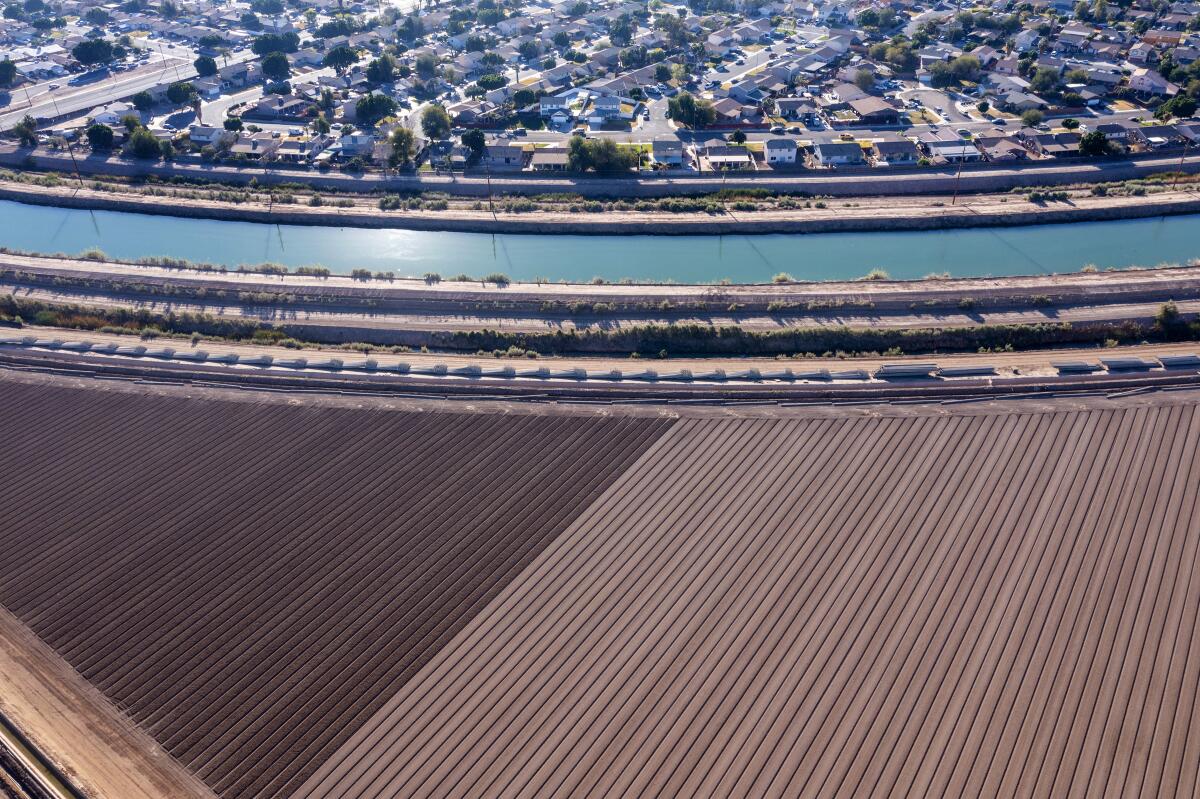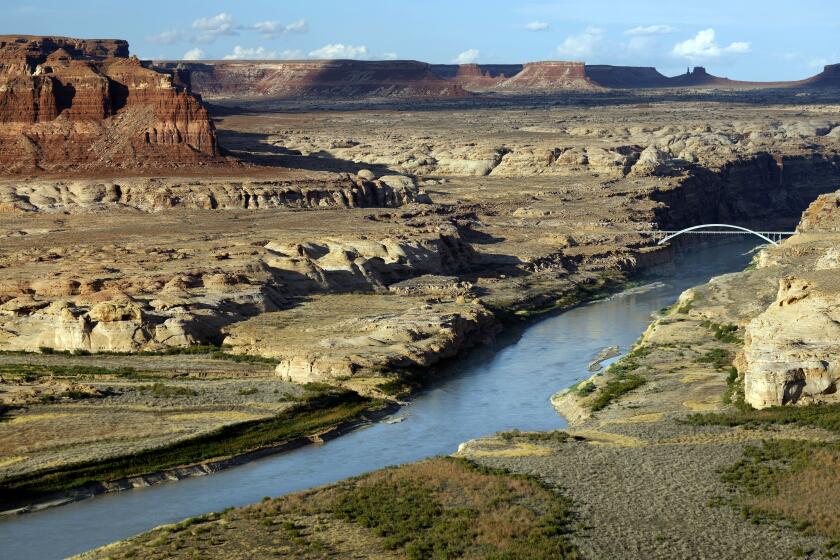California is alone in battle over Colorado River water cuts

- Share via
After a key deadline passed this week without an agreement on how to address the Colorado River’s crisis, California is now sharply at odds with six other states over how to take less water from the shrinking river.
Now that California has rejected a plan offered by the rest of the region, the state has entered a political tug-of-war with high stakes. So why has the state that uses the most Colorado River water decided to go it alone?
California appears to be banking on its high-priority senior water rights, while the other states are presenting a united front to show the federal government they support a plan that would have California give up more water.
“The strongest thing that the other basin states have going for them is some relative level of consensus. And the strongest thing California has going for it is the law,” said Rhett Larson, a professor of water law at Arizona State University.
“I think they’re playing to their strengths,” Larson said. “California is trying to play its best card, which is, ‘The law is on our side.’ And the other six states are trying to play their best card: ‘We are on each other’s side.’”
The parties are at an impasse as the federal government begins to weigh alternatives for rapidly reducing water use and preventing the river’s reservoirs from reaching dangerously low levels.
Colorado River in Crisis is a series of stories, videos and podcasts in which Los Angeles Times journalists travel throughout the river’s watershed, from the headwaters in the Rocky Mountains to the river’s dry delta in Mexico.
The Colorado River, which supplies cities, farming areas and tribal nations from the Rocky Mountains to the U.S.-Mexico border, has been pushed to a breaking point by chronic overuse, drought and the effects of global warming. The river’s two largest reservoirs, Lake Mead and Lake Powell, have declined to the lowest levels since they were filled.
Federal officials had called for each of the seven states that rely on the river to come up with alternatives for making water cutbacks by the end of January.
Under the proposal submitted by Arizona, Colorado, Nevada, New Mexico, Utah and Wyoming, a large portion of the proposed water cuts would be made by accounting for evaporation and other water losses along the lower portion of the river — a calculation that would translate into especially large reductions for California, which uses the largest share of the river.
In its proposal, California has reiterated previous commitments for Southern California water agencies to cut water use by 400,000 acre-feet per year, a reduction of about 9%, through 2026. The proposal also calls for making additional cuts in Arizona, California and Nevada on a tiered scale if the level of Lake Mead continues to decline toward critically low levels.
Colorado River reservoirs have fallen to alarming levels, prompting growing calls for urgent action to cut water use in seven states.
California Natural Resources Secretary Wade Crowfoot said the state’s proposal is “timely, practical and achievable in a way that works within existing law.”
The so-called “Law of the River” is based on the 1922 Colorado River Compact, which divided water among the seven states, as well as various court decisions and agreements of the last century. California’s agricultural water agencies, in particular the Imperial Irrigation District and Palo Verde Irrigation District, hold senior water rights that date back more than a century, giving California a privileged position under the prior-appropriation water rights system, often described as “first in time, first in right.”
Less than four years ago, the states seemed to be solving problems amicably, and agreed to water reductions in a deal called the Drought Contingency Plan. But those reductions haven’t been nearly enough as the reservoirs have continued to decline during the worst drought in centuries.
And tensions have risen over the past several months, especially between California and the rest of the region.
JB Hamby, the chair of California’s Colorado River Board, said in a submittal letter that the state’s proposal would “minimize the risk of legal challenge.”
Arizona water agencies released a statement Wednesday responding critically to California’s proposal, which they said “reflects a strict adherence to a California definition of the Law of the River.”
“But there are different interpretations of what that Law of the River actually means,” the Arizona Department of Water Resources and the Central Arizona Project said, adding that the six-state proposal is the “most equitable and efficient way” of dealing with the river’s severe water deficit due to drought, climate change and overuse.
Six states crafted a proposal for addressing the Colorado River crisis. Now, California has offered its counterproposal for dividing water cuts.
Now that the two sides have submitted starkly different proposals, the federal Bureau of Reclamation will begin reviewing the alternatives as part of a review that focuses on revising the rules for dealing with shortages.
Negotiations among the seven states are set to continue, but the impasse between California and the other states remains.
In the coming months, federal officials will play a key role as they analyze and weigh in on the proposals.
Whatever emerges from that process, the rift between the states now seems likely to trigger legal disputes and end up in court, Larson said.
“I think at this stage it’s inevitable and that’s where things are headed. And I also think it might be the best of our available options now,” Larson said. “We’re clearly not pulling together right now, and I think it’s probably time to try litigation.”










